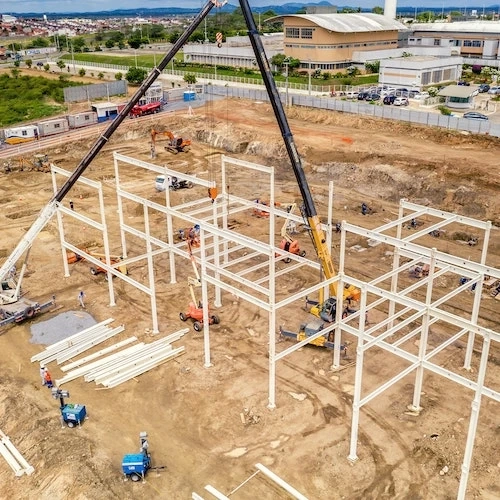Photo by Diego Pontes
Workplace safety is essential, regardless of industry. When a workplace is safe, employees can do their jobs without fear. Businesses can avoid costly mishaps, too. One common and overlooked hazard is falling objects. Imagine a tool dropped from a height or items tumbling from a shelf. Such incidents can cause serious injuries or even be fatal. It's more than just a bump on the head; it's about ensuring everyone returns home safely after work. That's why it's so important to be aware and take measures against these dangers.
Falling Objects Statistics
Falling objects in the workplace are a bigger problem than most realize. According to the Bureau of Labor Statistics, over 50,000 workers were hurt by objects dropping at work in just one year. Even more concerning is that nearly 250 of these incidents were fatal. That means almost every day, someone gets seriously hurt from something falling at their job.
These aren’t just numbers; they’re real people with families. Many of these injuries and deaths could have been prevented. Securing tools or storing items can make a massive difference. It's not just about being careful; it's about creating safe practices and habits at work. Remember these stats the next time you see a tool on a ledge or a box poorly stacked, and take a moment to fix it. Your action might prevent another statistic.
OSHA Falling Objects Safety Training
The Occupational Safety and Health Administration (OSHA) recognizes the potential dangers of falling objects, mainly aerial and scissor lifts. They have formulated safety protocols to address these hazards and promote a safer work environment. One of OSHA's notable documents, the Aerial Lift Fact Sheet, identifies falling objects as a leading risk for those operating aerial lifts.
OSHA's Standard 1926.451(f)(13) emphasizes keeping scaffolding, including aerial lifts, free from debris and work materials. This stipulation isn't just about cleanliness—it safeguards against potential hazards that can lead to severe injuries.
In addition to these guidelines, OSHA recommends several preventive solutions. Safety screens and other protective measures are advised to shield workers from the risk of falling objects. The underlying message is clear: training to prevent falling objects is paramount for those working around lifts.
Identifying Potential Hazards
Identifying hazards at work is a bit like being a detective. It's all about spotting things that could go wrong before they do. One critical method is routine inspections. Regularly checking out your workspace can catch risky situations, like a stack of boxes about to topple over.
Then there’s the tools and equipment. Have you ever left a hammer on a ladder or saw a tool on a high shelf? These are accidents waiting to happen, especially if someone bumps them or they slide off. It’s simple, but just putting tools back in their place can save someone from injury.
Always think about the environment in which you’re working. If it's windy, light items might get blown off. Machinery vibrations may also shake something loose. Being aware of your surroundings and doing these regular checks helps everyone stay safe.
Implementing Preventative Measures
If you’re serious about keeping your workplace safe, take a proactive approach. First, make sure tools and materials have their own "homes.” Just like you wouldn’t leave your phone on the edge of a table, don’t leave tools hanging around just anywhere. Using tool lanyards or nets can keep them in place, especially up high.
Next, walkways should be as clear as a sunny day. No clutter means fewer trips or items falling. Setting a regular tidy-up time can help with this. When it comes to gear, think of it as your armor. Hard hats can be life savers from falling items. And remember safety goggles and sturdy boots for extra protection.
Then there are signs – the big alert system. If there's work happening above or risks nearby, signs should shout it out.
Lastly, training is the brain behind safety. Regular sessions keep everyone sharp. If you see a risk, speak up. Safety is a team game!
What to Do If An Incident Occurs
Accidents can happen even in the safest places. If one does, act fast. Think of it like seeing a fire: you wouldn’t just walk by. Quickly getting them medical help is a top priority if someone is hurt. Arm yourself with advanced knowledge of where the first aid kit is located and who to call in an emergency.
Once the dust settles, write down what happened. Log the incident, like a slip or minor cut, even if it seems small. The documentation helps the company see patterns and prevent bigger issues.
Lastly, it's time to play detective again. Ask, "Why did this happen?" and "How can we stop it next time?" There could be a new safety rule to put in place or a different way to store items. Remember, the goal is to learn and ensure it doesn’t happen again.
Make Falling Objects Safety Training a Priority
Imagine if something as simple as a small tool or a bolt fell from a height. It could seriously hurt someone or even worse. That's why training on how to prevent falling objects is so important.
If you're working up high, like on a ladder or a lift, or even just stacking inventory on shelves, there’s always a risk something might fall. And remember, it's not just about the person up there; it’s about everyone below, too.
Training helps everyone understand these risks and shows them ways to prevent accidents. It teaches things like using nets, storing tools properly, and wearing safety gear, like hard hats.
Every workplace should make this training a priority. When a simple mistake could change someone’s life forever, we owe it to ourselves and our colleagues to prevent objects from falling.


